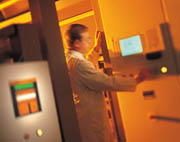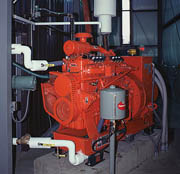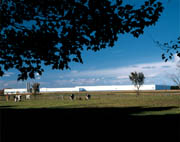
Even in regions where power costs are a relative bargain, management is biting the budgetary bullet and giving the green light to capital-intensive programs to better manage energy consumption. Rather than view energy investments in narrow return on investment (ROI) terms, firms are taking a more holistic view of the cost of inefficiency. And when they look at it critically, they often find that a lower electric bill is just the tip of the savings iceberg.
A blink in the system from the power company's perspective often is a disaster for a processor. With industrial rates hovering around a nickel a kilowatt hour (KW), Iowa food processors enjoy some of the most benign electric costs in the country. But downtime caused by poor quality power and occasional blackouts can produce production losses that dwarf those savings. Food plants have helped make Iowa one of the strongest markets for power monitors and other tools to improve energy performance.

"Getting the funding for the initial power monitors wasn't an easy sell," Robinson allows. Eight power monitors and the software to manage them represent a $26,000 expense, excluding installation and a server. More than 120 monitors hooked to Rockwell's RSEnergyMetrix are running in his plant. The payback from trend reporting and monitoring power usage and quality (wave forms, harmonics, voltage sags and surges, etc.) justifies the investment.
While EnergyMetrix is a useful tool, the best ROI came from fundamental changes in the way workers view energy use. "My focus was on controlling peak usage, but teams began identifying opportunities to lower the overall rates," Robinson says. Overall consumption has gone down in each of the last seven years, and 2004's reduction was expected to be eight percent. In addition, the equivalent of one day's downtime has been eliminated.
Power controls don't get the same priority as controls for processing and packaging machines, and the neglect is aggravated by plant complexity. Cereal, fruit snacks and desserts are produced in the 700-worker Cedar Rapids facility, and expansion resulted in "an electrical drawing so outdated, you couldn't use it," he adds. "Just by looking at the equipment and asking operators what was going on, I identified our transformers as the weakest link. They were being used as fuses." Diligent management brought an end to the days when a single motor could overload a distribution panel and take down a work area or the entire plant.
An attitude adjustment also is underway in the management of compressed air, a power source estimated to account for 10 percent of electric costs in industrial buildings. Hissing hoses and oversized compressors have been addressed by many plant engineers; the new frontier is variable speed drives (VSD) on compressor motors. Pressure transducers detect deviations from a set point in the line, and motor speed increases or slows to compensate. Pressure deviations of 30-60 psi are common in compressed air systems, which means VSD can boost efficiency 15% to 30%, according to Bryan Fasano, marketing manager at Quincy, IL-based Gardner Denver.
Some plant engineers retrofitted their compressor motors with VSD years ago, and factory-installed VSD became an option in recent years. Gardner Denver had cobbled together a VSD setup that helped users boost efficiency 7% to15%, Fasano says. Working with Rockwell's Reliance motor division and Allen-Bradley controls, the company is rolling out a line of compressor air-ends that double those efficiencies.
Crisis response
Nothing kick-starts an efficiency program like a crisis. With more regions of the nation getting a taste for operating in power-crisis mode, energy-conservation systems are finding a more receptive audience.
A third of the cost of an engine generator at Aarhus United USA Inc.'s Port Newark, NJ, plant is being picked up by the New Jersey Clean Energy Program. Distillate from palm oil and coconut oil processes will power the engine, qualifying it as a renewable energy source while eliminating tipping fees for disposing of the byproduct.
The Aarhus system is engineered by Northern Power Systems, a Waitsfield, VT, design firm that has watched interest in combined heat and power systems wax and wane with each passing crisis. A 1-megawatt critical load support (CLS) system from Northern came on line at Coca-Cola's Pokka USA bottling plant in Marin County, CA, in Spring 2003. While rising natural-gas prices eroded the expected savings when the contract was signed 12 months earlier, power reliability also was an issue. The 150,000-sq.-ft. facility experienced 24 power failures in the two previous years. Interruptions too short to qualify as outages but long enough to disrupt sophisticated PLCs plagued the bottler of noncarbonated juices and teas and forced four to six-hour shutdowns. "Getting plant managers to calculate shutdown costs accurately is the hard part of cost-justifying these projects," Northern Vice President Charles Curtis notes. "They tend to underestimate."
Green Mountain Coffee Roasters is another food processing client of Northern. With industrial electricity at 10 cents per KW, Waterbury, VT-based Green Mountain contends with rates only slightly less than California processors. Heat recovered from two propane-powered Waukesha Enginator generators heats water for sanitation, and the superior efficiency of the back-up units compared to the electric grid is a plus in an environmentally conscious state like Vermont, says Paul Comey, vice president of facilities. But the greatest benefit is uninterrupted power.
"When you roast beans close to or 10
Valley of darkness
In distribution centers and warehouses, lighting may account for half or more of the monthly electric bill. Selecting a new system is not an easy task, however. Advancing technology and trade-off considerations complicate upgrade decisions. Confronted with a glut of options, many facility engineers punt and invest capital elsewhere.
"Fluorescents probably would have been even more efficient," points out Platt. "The problem is that the space is only heated to 40
